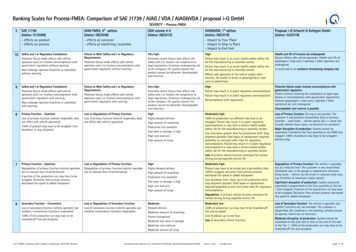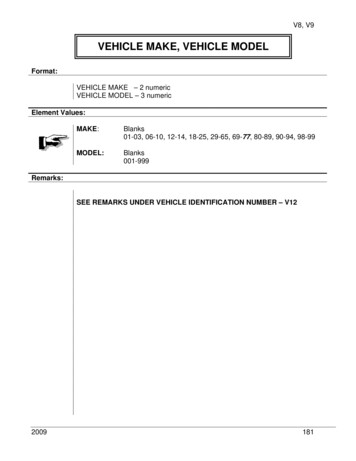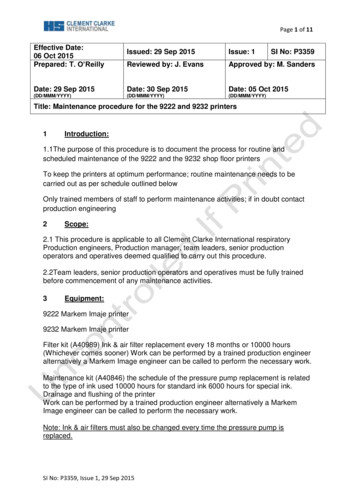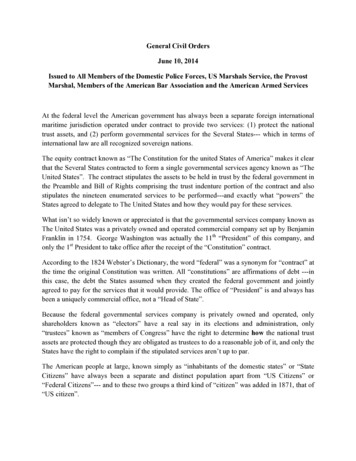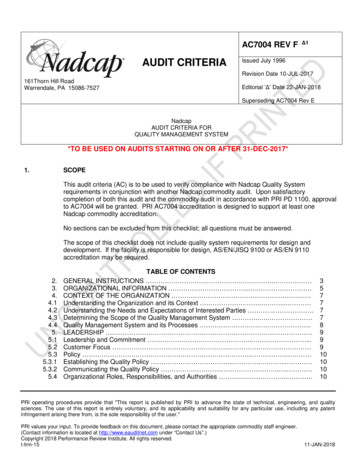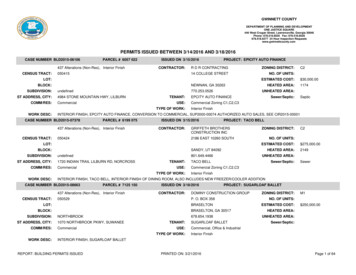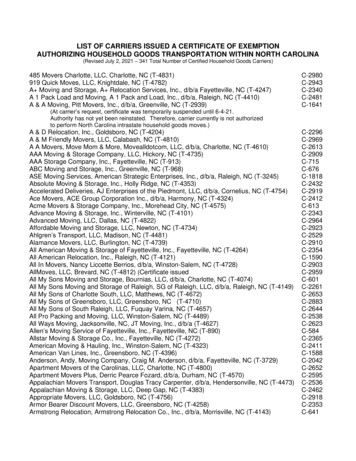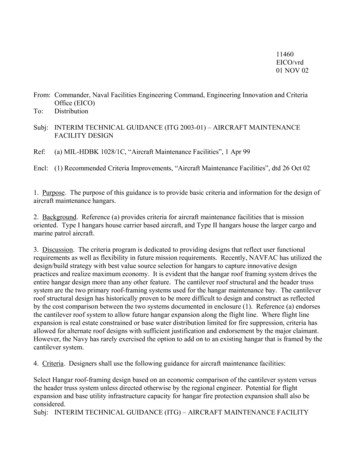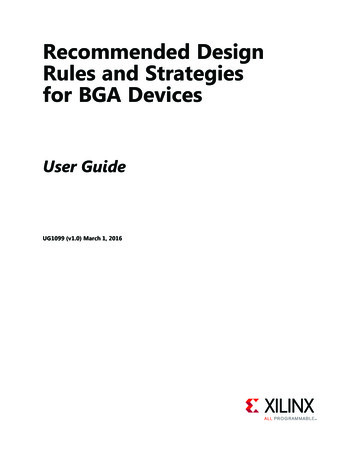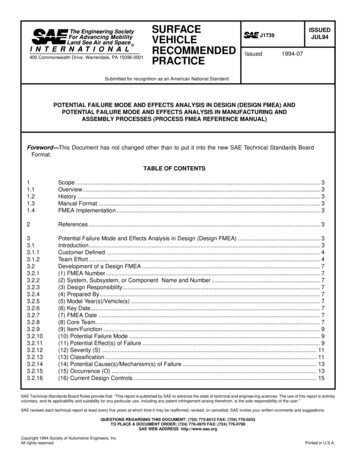
Transcription
400 Commonwealth Drive, Warrendale, PA UL94J1739Issued1994-07Submitted for recognition as an American National StandardPOTENTIAL FAILURE MODE AND EFFECTS ANALYSIS IN DESIGN (DESIGN FMEA) ANDPOTENTIAL FAILURE MODE AND EFFECTS ANALYSIS IN MANUFACTURING ANDASSEMBLY PROCESSES (PROCESS FMEA REFERENCE MANUAL)Foreword—This Document has not changed other than to put it into the new SAE Technical Standards BoardFormat.TABLE OF CONTENTS11.11.21.31.4Scope . 3Overview. 3History . 3Manual Format . 3FMEA Implementation . 32References . .2.16Potential Failure Mode and Effects Analysis in Design (Design FMEA) . 3Introduction. 3Customer Defined . 4Team Effort . 4Development of a Design FMEA . 7(1) FMEA Number . 7(2) System, Subsystem, or Component Name and Number . 7(3) Design Responsibility. 7(4) Prepared By . 7(5) Model Year(s)/Vehicle(s) . 7(6) Key Date. 7(7) FMEA Date . 7(8) Core Team. 7(9) Item/Function . 9(10) Potential Failure Mode . 9(11) Potential Effect(s) of Failure . 9(12) Severity (S) . 11(13) Classification . 11(14) Potential Cause(s)/Mechanism(s) of Failure . 13(15) Occurrence (O) . 13(16) Current Design Controls. 15SAE Technical Standards Board Rules provide that: “This report is published by SAE to advance the state of technical and engineering sciences. The use of this report is entirelyvoluntary, and its applicability and suitability for any particular use, including any patent infringement arising therefrom, is the sole responsibility of the user.”SAE reviews each technical report at least every five years at which time it may be reaffirmed, revised, or cancelled. SAE invites your written comments and suggestions.QUESTIONS REGARDING THIS DOCUMENT: (724) 772-8512 FAX: (724) 776-0243TO PLACE A DOCUMENT ORDER; (724) 776-4970 FAX: (724) 776-0790SAE WEB ADDRESS http://www.sae.orgCopyright 1994 Society of Automotive Engineers, Inc.All rights reserved.Printed in U.S.A.
SAE J1739 Issued 64.2.174.2.184.2.194.2.204.2.214.2.224.2.23(17) Detection (D) . 15(18) Risk Priority Number (RPN) . 17(19) Recommended Action(s) . 17(20) Responsibility (for the Recommended Action) . 19(21) Actions Taken . 19(22) Resulting RPN . 19(23) Follow-Up . 19Potential Failure Mode and Effects Analysis in Manufacturing and Assembly ProcessesFMEA).21(ProcessIntroduction . 21Customer Defined . 21Team Effort . 21Development of a Process FMEA . 23(1) FMEA Number. 23(2) Item . 23(3) Process Responsibility . 23(4) Prepared By . 23(5) Model Year(s)/Vehicle(s). 23(6) Key Date . 23(7) FMEA Date . 23(8) Core Team . 23(9) Process Function/Requirements . 23(10) Potential Failure Mode. 25(11) Potential Effect(s) of Failure. 25(12) Severity (S). 27(13) Classification . 27(14) Potential Cause(s)/Mechanism(s) of Failure. 29(15) Occurrence (O). 29(16) Current Process Controls . 31(17) Detection (D) . 31(18) Risk Priority Number (RPN) . 33(19) Recommended Action(s) . 33(20) Responsibility (for the Recommended Action) . 33(21) Actions Taken . 33(22) Resulting RPN . 35(23) Follow-Up . 35Appendix A Design FMEA Block Diagram Example . 36Appendix B Design FMEA Example. 37Appendix C Process FMEA Flow Chart/Risk Assessment Example . 38Appendix D Process FMEA Example . 39Appendix E Glossary. 40Appendix F Standard Form for Design FMEA. 41Appendix G Standard Form for Process FMEA . 42-2-
SAE J1739 Issued JUL941.Scope—General Information1.1Overview—This SAE Recommended Practice was jointly developed by Chrysler, Ford, and General Motorsunder the sponsorship of the United States Council for Automotive Research (USCAR).This document introduces the topic of potential Failure Mode and Effects Analysis (FMEA) and gives generalguidance in the application of the technique. An FMEA can be described as a systemized group of activitiesintended to: (a) recognize and evaluate the potential failure of a product/process and its effects, (b) identifyactions which could eliminate or reduce the chance of the potential failure occurring, and (c) document theprocess. It is complementary to the design process of defining positively what a design must do to satisfy thecustomer.1.2History—Although engineers have always performed an FMEA type of analysis on their designs andmanufacturing processes, the first formal application of the FMEA discipline was an innovation of theaerospace industry in the mid-1960s.1.3Manual Format—For ease of use, this reference manual retains the presentation of the FMEA preparationinstructions in two distinct sections (design and process). However, having both sections in the same manualfacilitates the comparison of techniques used to develop the different types of FMEAs, as a means to moreclearly demonstrate their proper application and interrelation.1.4FMEA Implementation—Because of a company's commitment to continually improve its products wheneverpossible, the need for using the FMEA as a disciplined technique to identify and help eliminate potentialconcern is as important as ever. Studies of vehicle campaigns have shown that a fully implemented FMEAprogram could have prevented many of the compaigns.Although responsibility for the "preparation" of the FMEA must, of necessity, be assigned to an individual,FMEA input should be a team effort. A team of knowledgeable individuals should be assembled: e.g.,engineers with expertise in Design, Manufacturin
SAE J1739 Issued JUL94-7-3.2 Development of a Design FMEA— The design responsible engineer has at his or her disposal a number of documents that will be useful in preparing the Design potential FMEA. The process begins by developing a listing of what the design is expected to do, and what it is expected not to do, i.e., the design intent. Customer wants and needs, as may be determined from .
